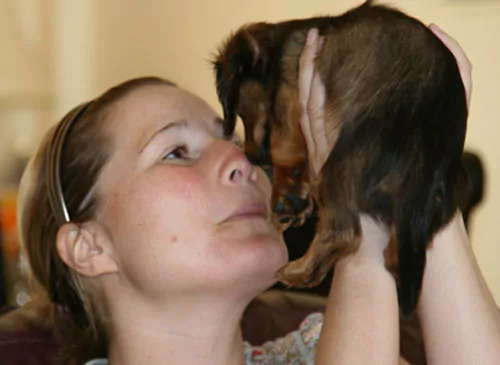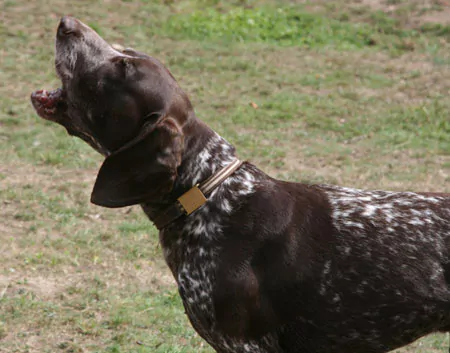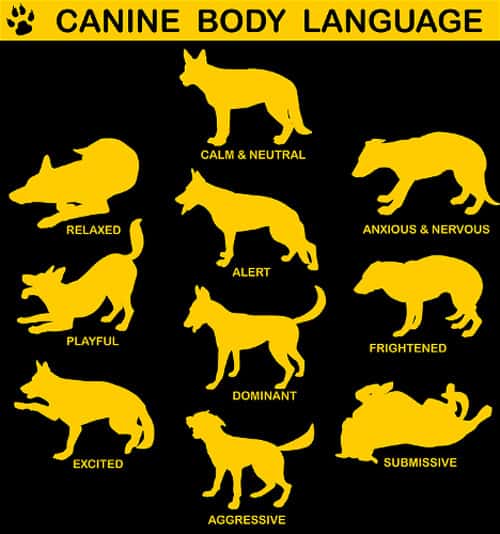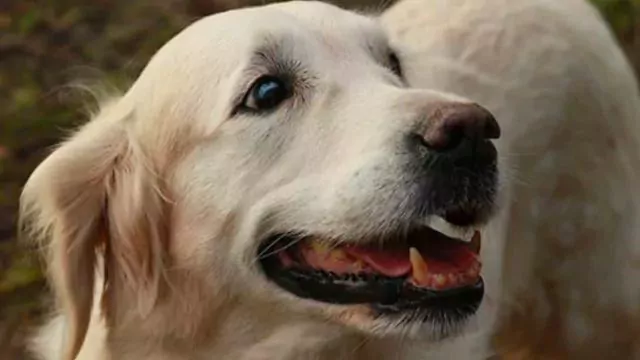Dog Communication & Body Language
To understand dogs behaviour you must be able to understand their canine body language. A guide to reading their language,
To really understand our dogs you need to be able to listen and more importantly see what they are trying to tell us

I was also on LBC, discussing the merits and usefulness of a new dog collar that was also a mobile phone. You could ring up and converse with your dog at any time, and enjoy a nice cosy chat
You might as well text your pet for all the good phoning would do; The most likely outcome would be to startle and frighten your pet.
In reality, real canine language is not just verbal; it is a rich visual language, where dogs are able to converse with each other irrespective of breed or nationality. A Collie from Wales can converse with an Akita from Japan and a Poodle living in Germany with a village dog in Ethiopia. Did you know that a Poodle is German, not French?
It is a German gundog that retrieves ducks and geese out of water. That strange haircut is to stop them from getting waterlogged as they do not shed fur. They cut all the hair that is not protecting joints and vital organs, therefore, stopping them from becoming exhausted with the weight of water in their normally dense fur.
Dogs Language: Dogs have a truly universal body language that can be incredibly subtle and wide-ranging. and is primarily visual rather than verbal.
Is the dog shown below being aggressive? The answer is no, he is smiling and it is one of a number of body language indicators that are only used towards humans.
They don’t give puppy eyes to other dogs or pleading doe eyes and they do not smile at other dogs. They mimic our expressions and smiling is just one of many expressions they show us.
It can also be an appeasement gesture to calm you down, as they see that when you are happy and relaxed you often smile, they think mimicking that smile will diffuse a situation where they may feel anxious.
Dalmations and Hungarian Vizsla’s are common smilers, as are many other breeds. If you have a smiler post a picture in the comments section at the bottom of the page.

However, this is a language that needs to be practised and learned for our dogs to be fluent during the early canine socialisation period.
That is why early socialisation, puppy classes, and controlled play with other vaccinated dogs and especially other puppies is so vitally important, during the critical period canine socialisation period from 7 to 16 weeks. See (1) Critical Periods Puppies
As a behaviourist, I get to treat many of these animals that are unable to give calming signals or are stunted in their ability to meet and greet because of the lack of early socialisation.
These are normally the ones that have fear and animosity towards other dogs and sometimes humans, culminating in the most common aggression of all “Fear-based reactive aggression”.
In many cases, they are unable to understand or signal their intentions; a classic example is boxers who are often attacked by other dogs.
They have been bred with flattened features that are almost immobile, then we used to dock their tails to a tiny useless stub, making them unable to display some of the facial and tail signals that are so important in the greeting ritual. I said earlier that we can learn this language, however, some aspects of canine language are so complex, that we cannot even start to reproduce it with our puny two legs, small immobile ears, and lack of a tail.
We are further hampered by the fact that we tend to think that our pets can understand complex thought patterns; we assume a dog’s level of understanding is on a par with our own.
This is known as “anthropomorphism”, the dictionary definition is “The attribution of human motivation, characteristics, or behaviour to nonhuman organisms or inanimate objects”. It is a bit like saying that a vine climbed up the tree to getter a better view of the garden.
| Is your dog pulling on the Lead, Unruly, Bad Recall, Aggressive on Lead, Jumping Up? See my article and Video Clips on how to stop this. The Jingler |

Dogs and Vocalisation: Dogs do bark and vocalise, it is a part of their ability to converse, this is only one factor in your dog’s language repertoire, effectively when they bark they are saying different types of “Heyyyyy”.
This can be happy, demanding or questioning. They also communicate verbally in other ways the excited Yip when you get the lead out, the bark they make when someone is at the door, quite different from the nervous bark when they hear something unusual.
Having said that true communication comes from the glance, the head position, the body posture, and a myriad of other signals constantly being passed back and forth.
Dogs try to converse with us, but without understanding the subtly of the language we often miss most of what they are trying to convey. This can cause misunderstanding, confusion and frustration, and can be one of the main reasons we see some of the many behavioural problems in our pets
Greeting and Appeasing Signals: Humans are the direct descendants of primates including ape’s chimpanzees, bonobos, and gorillas.
That is not to denigrate our unique position on the evolutionary ladder, but our heritage is none the less, Primate.
Dog’s Ancestry is intrinsically linked to the wolf, therefore, Canids, which include wolves, coyotes, and jackals, a very different species with very different body language.
Where communication sometimes breaks down is when we greet other species, we tend approach then as we would humans, face on making full eye contact;
We often hug, face to face, putting our faces close together. Just look at the common greeting of kissing both cheeks. To a dog, this is a threatening gesture and is deemed rude and inappropriate.
Have you ever seen dogs hug other dogs they will hug us sometimes but they are once again only copying and mimicking our actions? In the main, most of our pets suffer this indignity in silence but not always. This is one of the reasons people are bitten, especially young children under five, who tend to cuddle everything they can get their hands on.

This coupled with the fact that you cannot negotiate with a child under five, you have more chance of negotiating with a terrorist. Ask any mother, this sadly makes the toddler one of the most frequent victims of dog bites.
If you stand over a dog and ruffle the top of its head this can also be perceived as threatening, imagine someone coming up to you and ruffling your hair every time you met, how would you feel?
(2) Turid Rugaas The Norwegian behaviourist and acknowledged expert on reading the intricate body language of our canine companion’s states that dogs have a highly developed set of calming signals that act as diffusers of aggression and conflict.
These signals include circling, lip licking, yawning, sniffing the ground, looking away, moving very slowly and deliberately, the body shakes as if shedding water, distracted sniffing, and either sitting or lying down. These signals are aimed at other dogs but are also directed at us, who are also perceived very loosely as pack members. Though dogs do not see us as another dog. See (3) The Alpha Myth
Just as we expect our pets to understand our every word, then dogs think we can interpret their signals, quite often these are the ones we miss when our dogs are stressed or worried. If you can spot them you can actually signal back calming gestures in response such as yawning, lip licking, moving slowly, and looking away. This helps to diffuse the situation and relax your pet. If you think about it, these actions are the opposite of the aggressive stance that dogs take as a prequel to an attack or dogfight.

Aggression: As opposed to the calming signals, this body language is initially easier to read and includes ears pinned back flat against the head, or sometimes pointed forward.
Hackles are normally raised, the hard stare, low head stance, stiff-legged walk, lips skinned back, and tail either upright and quivering or straight out not wagging.
There may be low growling or a snarl. Sometimes the dog gives a whale eye, this is when the head is turned slightly away but the eyes showing the whites are turned towards you. This is often the look when the dog is guarding something like a bone.
All these signals are a threat, the dog is saying stop what you are doing or there could be violence.
In Wolf packs, these threat displays are a way of controlling the hierarchical structure, the breeding males and females will control their pack position by these overtly aggressive stances.
Rarely does it turn into violence these animals cannot really afford to be injured or hurt in an all-out fight, therefore threat displays normally suffice?
Because of our and sometimes other dogs, inability to read the postures and body language and give calming signals in return means that sometimes the threats can actually escalate into physical violence.
Timid Dogs: If you find that your dog is very fearful or timid around strangers get them to walk him on a lead with you, it calms and gives confidence to the stressed dog, make sure you are walking next to the dog at the same time
In conclusion, we need to watch and learn from our pets, if you write down the numerous signals your pet gives and in what context you will gradually build up an understanding of what he is saying to you You can then signal back appeasing signals in return turn your head away, yawn, or lick your lips at a fearful or aggressive dog and you may just diffuse the situation.
With practice and given time, you should find yourself able to communicate with your dog with a more enriched and sophisticated vocabulary. This will benefit both you and your dog and will result in a stronger bond and understanding of each other’s needs.
Stan Rawlinson
© June 2005
Updated regularly last updated 2020
(2) Turid Rugaas
(3) The Alpha Myth






